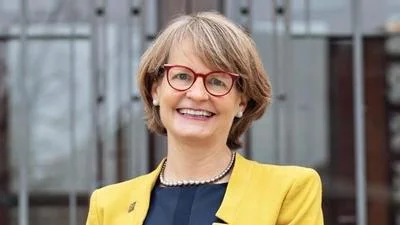Santa J. Ono, Ph.D. President at University of Michigan - Ann Arbor | Official website
Santa J. Ono, Ph.D. President at University of Michigan - Ann Arbor | Official website
The University of Michigan is advancing its efforts toward carbon neutrality by testing a new approach to geoexchange technology. The university is conducting a test borehole that reaches a depth of 1,600 feet, which is about twice as deep as conventional geoexchange systems typically drilled on campus.
This project uses oil and gas drilling techniques rather than standard water-well rigs to install a closed-loop system farther below the surface. The test aims to assess subsurface conditions and evaluate the performance of deeper geoexchange installations before committing to larger-scale projects.
According to Shana Weber, associate vice president for campus sustainability, "With this project, the University of Michigan is not only investing in renewably powered, highly efficient heating and cooling technologies, but also exploring innovative approaches that could accelerate our long-term energy transition efforts. If successful, the approaches we’re testing today are poised to inform similar efforts locally and across the country."
Geoexchange systems work differently from traditional fossil-fuel-based heating and cooling by using ground-sourced heat pumps. These pumps rely on Earth's stable underground temperatures to transfer heat into or out of buildings through sealed piping. This process allows for more efficient year-round operation and helps reduce both carbon emissions and water usage on campus.
The data gathered from this test will inform decisions related to U-M’s Campus Plan 2050, which focuses on modernizing district-scale heating and cooling systems while aiming for significant reductions in greenhouse gas emissions by 2040.
Geoff Chatas, executive vice president and chief financial officer at U-M, stated: "The test well gives us critical data to understand the limits and potential of deeper geoexchange boring technologies to support our long-term carbon neutrality goals. It reflects our role as a living learning laboratory, testing real-world solutions and sharing what we learn."
In addition to energy efficiency benefits, these systems are expected to improve local air quality by reducing reliance on natural gas-powered heating systems. They also require less water compared with traditional cooling towers.
U-M has previously implemented geoexchange projects such as the Hayward Street system (99 borings at 700 feet) and the Ginsberg Building system (eight borings at 535 feet). Current construction projects like Central Campus residential development—featuring over 80 borings at depths up to 800 feet—and the Ginsberg Building are seeking LEED Platinum certification in part due to their use of geoexchange technology.
Kambiz Khalili, associate vice president of student life at U-M said: "Sustainability is critically important for our students and campus community. We strive to design and construct buildings that meet the needs of current and future Wolverines. Partnering across campus units allows our buildings to be at the leading edge of efficiency and sustainability, to meet the moment and encourage others to look to Michigan for solutions."
The borehole test is being performed by Walbridge in collaboration with CUDD Pressure Control. Students, faculty, and staff have been able to observe these developments firsthand as part of U-M's commitment to integrating innovation into campus planning and operations.






 Alerts Sign-up
Alerts Sign-up